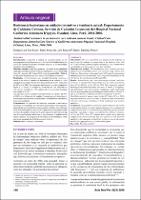| dc.contributor.author | Paz Rojas, Enrique Luis | |
| dc.contributor.author | Ponce de León Pandolfi, Darío | |
| dc.contributor.author | Ramírez Ponce, Rafael | |
| dc.date.accessioned | 2019-04-11T15:27:34Z | |
| dc.date.available | 2019-04-11T15:27:34Z | |
| dc.date.issued | 2008 | |
| dc.identifier.citation | Acta Médica Peruana. 2008; 25(3). | es_PE |
| dc.identifier.uri | https://hdl.handle.net/20.500.12959/238 | |
| dc.description.abstract | Introducción: se describe y analiza el comportamiento de los
microorganismos más frecuentes en el Servicio de Cuidados Intensivos
(UCI) del Hospital Guillermo Almenara Irigoyen, y su sensibilidad/
resistencia a los antibióticos.
Material y método: se identifica gérmenes y la técnica de susceptibilidad
empleada, realizado mediante el sistema automatizado Micro Scan Walk
Away 96 y paneles MIC Combo NUC entre el periodo 2004 y 2006 de
los pacientes hospitalizados en el servicio de Cuidados Intensivos.
Resultados: el Acinetobacter spp. presentó frecuencia creciente, a
través de los años de estudio con incremento de su resistencia a los
carbapenem en el lapso de tres años desde un 0% en el 2004 hasta cerca
del 40 % en el 2006. Los gérmenes más frecuente en vías respiratorias
fueron el S. aureus, P. aeruginosa y Acinetobacter y en hemocultivos
el S. aureus, Candida sp y el S. epidermides. S. aureus fue el germen
más común en la UCI.
Las cepas de S. aureus oxacilino resistentes en la UCI, variaron del 93%
al 100% en el ultimo año del estudio. P. aeruginosa y el Acinetobacter
son bacterias con resistencia creciente tanto a los antibióticos tradicionales
como a los modernos.
Conclusiones: la explosión de infección resistente a antibióticos
continúa a nivel mundial y por otro lado la declinación en investigación y
desarrollo de nuevos antibióticos hacen sombrío el futuro principalmente
de las infecciones graves y más aun en el epicentro de la resistencia como
es el área de cuidados intensivos.Ya que los pacientes de UCI tiene alta
tasa de complicaciones infecciosas y son expuestos a antibióticos de
amplio espectro, la emergencia de resistencia antimicrobiana ha hecho
que el uso apropiado de antibióticos sea un objetivo. | es_PE |
| dc.description.abstract | Introduction: This is a description and analysis of the behavior of
most frequently isolated microorganisms in the Intensive Care Unit
(ICU) of Gullermo Alemnara-Irigoyen Hospital in Lima. Antimicrobial
susceptibility/resistance patterns were also analyzed.
Material and method: Microorganisms were isolated and their
antimicrobial susceptibility patters were assessed using a Micro Scan
Walk Away 96 automatic system and Combo NUC panels for determining
minimal inhibitory concentrations (MIC) in patients hospitalized in the
ICU during the period between 2004 and 2006.
Results: Acinetobacter spp. were increasingly isolated, and their
resistance to carbapenem antimicrobials rose in a three-year period,
from 0% in 2004 to nearly 40% in 2006. Most frequently isolated
microorganisms in the respiratory tract were: S. aureus, P. aeruginosa,
and Acinetobacter spp.; and S. aureus, Candida spp., and S. epidermidis
were the most frequently isolated pathogens in blood cultures. Overall, S.
aureus was the most commonly isolated microorganism in the ICU.
Oxacillin-resistant S. aureus strains in the ICU had a 93% to 100%
frequency in the last year of the study. P. aeruginosa and Acinetobacter
spp. have increasing resistance to both traditional and modern
antibiotics.
Conclusions: The pandemic of antibiotic resistant infections all over the
world, and the decline in research and development of new antibacterial
compounds may lead us to a somber future, particularly in cases of severe
infections, especially in places most affected by antibiotic resistance,
such as the ICUs. Since ICU patients have a high rate of infectious
complications and considering they are exposed to wide-spectrum
antibiotics, this emergence of antibiotic resistance stresses the urgent
need for the appropriate use of antimicrobial agents. | |
| dc.format | application/pdf | es_PE |
| dc.language.iso | spa | es_PE |
| dc.publisher | Colegio Médico del Perú | es_PE |
| dc.relation.uri | https://amp.cmp.org.pe/index.php/AMP/article/view/1407 | |
| dc.rights | info:eu-repo/semantics/openAccess | es_PE |
| dc.rights.uri | https://creativecommons.org/licenses/by-nc-nd/4.0/ | es_PE |
| dc.source | Seguro Social de Salud (EsSalud) | es_PE |
| dc.source | Repositorio Institucional EsSalud | es_PE |
| dc.subject | Ciencias de la Salud | es_PE |
| dc.subject | Farmacorresistencia Microbiana | es_PE |
| dc.subject | Resistencia bacteriana | |
| dc.subject | Bacterial resistance | |
| dc.title | Resistencia bacteriana en cuidados intensivos y tendencia actual: Departamento de Cuidados Críticos, Servicio de Cuidados Intensivos del Hospital Nacional Guillermo Almenara Irigoyen, Essalud, Lima, Perú, 2004-2006. | es_PE |
| dc.title.alternative | Antimicrobial resistance in an intensive care unit and current trends: Critical Care
Department, IntensiveCare Service of Guillermo Almenara-Irigoyen National Hospital,
EsSalud, Lima. Peru, 2004-2006 | |
| dc.type | info:eu-repo/semantics/article | es_PE |
| dc.subject.ocde | https://purl.org/pe-repo/ocde/ford#3.03.09 | es_PE |
| dc.subject.ocde | https://purl.org/pe-repo/ocde/ford#3.03.08 | es_PE |
| dc.publisher.country | PE | es_PE |






